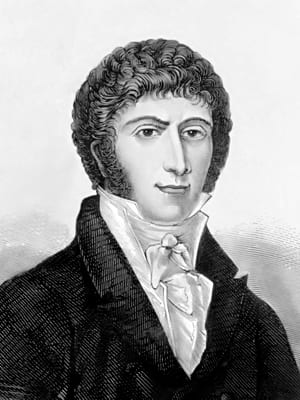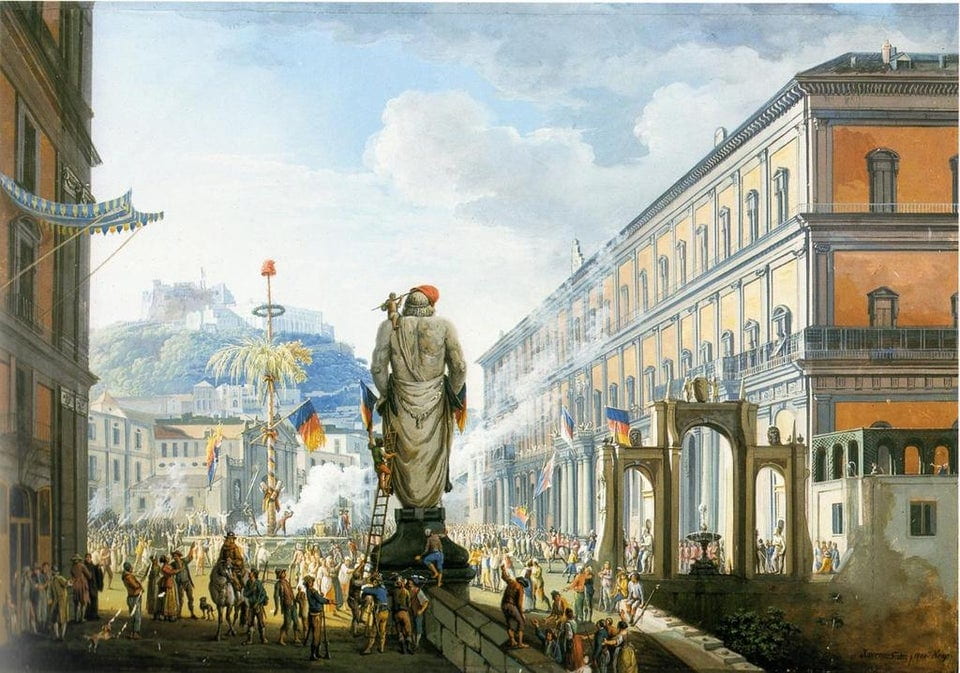By Contributing Writer Thomas Furse
In a letter to a fellow republican during the 1799 Neapolitan Revolution, Vincenzo Cuoco proclaimed, ‘our philosophers, my dear friend, are often deceived by the idea of something excellent which is the worst enemy of the good’ (Cuoco, Saggio Storico, 228). Politicians and revolutionaries have often grappled for the perfect constitution or government; defeat in this pursuit appears tantamount to failure. For Italian thinker Vincenzo Cuoco (1770 – 1823), revolutionary failure in 1799 brought him exile, but his optimism for progress did not recede. He reflects on this in his book, Saggio Storico sulla rivoluzione di Napoli (Historical Essay on the Neapolitan Revolution of 1799), which ascribes the failure of the Neapolitan Revolution to the rupture between the revolutionaries and the people they were meant to be liberating.
Several republican revolutions sprang up against tyrannical governments at the end of eighteenth century. The Neapolitan Revolution followed the republican revolutions in America, France, the Brabant revolution in Belgium (1789-90), and the United Irish rebellion (1798). Each of these revolutions had radical and conservative factions that disagreed on what should come after the seizure of power. Cuoco, however, developed a moderate, even conservative path to instituting a republican government. He was an administrator for the new government that with French support overthrew King Ferdinand of Naples. But the republic lasted only six months. Popular discontent, royalist conspiracies, mismanagement by the republican government, and military defeats restored the old monarchy. During the restoration, a royalist terror campaign executed revolutionaries with a bloodthirstiness that politicians across Europe denounced. Luckily, Cuoco escaped.

According to Cuoco, the roots of republican defeat lay in Italy with the revolutionaries themselves. The revolutionaries were too enamoured with the 1789 French Revolution. He declared, ‘the French Revolution was understood by only a few, was approved of by even fewer, and wanted by almost nobody,’(Cuoco, Saggio Storico, 42). For Cuoco, Italians’ failure came from their attempt to transfer the ‘alien ideology’ of abstract rationalism from Jacobin France to southern Italy. He created the term ‘passive revolution’ to explain this, which he imputed to the separations in society. ‘Passive revolution’ diagnosed that Italian revolutionaries had the ideological fervor and resources necessary to overthrow the monarchical power, but that the people felt apathetic, or worse, hostile to revolutionary change.
Cuoco had studied law in Naples, which was one of the largest cities in Europe and a center of the Italian and European enlightenments. His participation in this intellectual culture led to working for the economist, Giuseppe Maria Galanti, a critic of feudalism and aristocratic power. From this, Cuoco grew sympathetic to calls for democracy and republicanism. Although not aligned with the radical Jacobinism that captured many southern intellectuals, Cuoco engaged in political debates in Naples and later during his exile. He always remained ideologically flexible, from supporting the republican revolution in 1799, to working for monarchs, Joseph Bonaparte and Joachim Murat, in 1806 and 1808.
*
From Saggio Storico and his 1799 letters to Vincenzio Russo we get the impression that Cuoco understood that radicalism was not the answer. He turned to study the revolution not out of deep disappointment, but ‘to alleviate the leisure and tedium of exile.’ In this light, Cuoco positions himself as a detached observer. These letters illustrate a much stronger line against a French-inspired Jacobin constitution. The precise date of these writings is debatable, and they may have even been fictitious to bolster Cuoco’s intellectual standing. But certainly the letters show that Cuoco remained active in Italian political debates after June 1799 (de Francesco, Naples in the Enlightenment, 170-171). Combined with the short and relatively self-contained chapters in Saggio storico, it indicates that Cuoco wanted people to read his work—and learn from it. He was in the battle to explain European politics, and his involvement in this was a radical act that could be punished. Saggio Storico lists how the revolutionaries were separated from almost everyone else, and that this chasm was the main obstacle to success. Cuoco suggested that the concerns of ordinary people barely registered with the revolutionaries, many of whom were aristocrats. The French troops who initially drove away King Ferdinand became reluctant to give full support to the new republican government and abandoned it. Cuoco proclaimed that the French moreover worked against the republicans when they disarmed them. This frustrated attempts to recreate the king’s old army as a republican army. The lazzaroni, the staunchly monarchist lower class, deepened the division between the government and the people.
Based on this postmortem, Cuoco advocated that a middle path could harmonize social relations during a revolution. He displayed his democratic zeal and moderation concurrently: ‘the secret of revolutions is this: to know what all the people want, and to do that… the obsession with reforming everything leads inevitably to counter-revolution’ (Cuoco, Saggio Storico, 96). We could dismiss this as ideological incoherence. But for Cuoco, respecting tradition and enacting reforms was the path to power. Successful revolutionaries had to tack toward prudent reform to succeed in their aims. In this insistence, Cuoco leans away from the conservatism of Edmund Burke in Reflections (1790), and more toward a reforming attitude for democratic politics and governance.
This emphasis on practical considerations shaped his vision for a united Italy. Distinctive patterns of local life had to organically relate to a new national space, and not be forced to change. Accordingly, starry-eyed radicalism and foreign support could not deliver a fair and just government. For a united Italy, he argued that federation had significant drawbacks, but also ‘infinite advantages.’ Although Cuoco does not name it, his argument was in remarkable contrast to the centralized Jacobin government of revolutionary France. An all-powerful government would be like a ‘single eye’ with a ‘single arm.’ Yet, in a federal system power would be better dispersed among the people and the elites. A federation could respect local needs and forge a new Italian political space. Cuoco’s argument throughout Saggio storico, among his other works, became a mainspring for the ideas behind the Italian Risorgimento from 1815 to 1871. His moderate path inspired the conservative politics of Camillo Benso, Count of Cavour, who succeeded in uniting Italy with Giuseppe Garibaldi in 1861.
Saggio storico does not present us a narrative with a beginning, middle, and end that would match the rise, establishment, and fall of the Neapolitan Republic. Instead, it judges how and why the republic failed. There are relatively discrete chapters on military strategy and public order, and more philosophical tracts on the nature of liberty and how property law ought to reflect social equality in a republic. By reflecting on the revolution this way, Cuoco conveys the problems of installing a government led by a small group detached from the populace. The new government could not solve all the mounting and simultaneous problems, from public order to guarding liberty, from education reform to repealing feudalism. In one chapter, Cuoco points out that the new government gave the appearance of organization, but neglected its ‘most essential part’— communication (Cuoco, Saggio Storico, 162). The government did not engage with other parts of Italy, communicate orders to the provinces—or even between government departments. Saggio storico, like his other work, Platone in Italia (Plato in Italy), catches him looking back to failure, and forward to the hope of progress.
*
Cuoco writes in his conclusion, ‘destiny is ensuring that the kings strive to prepare the work attempted unsuccessfully by the republicans’ (Cuoco, Saggio Storico, 223). For Cuoco, failure and success are joined; the roots of one are enmeshed in the progress of the other. The brutal restoration of King Ferdinand in 1799 after the republic’s end had sown seeds for the next revolution. His reflections then are not a surrender of hope, but a polemical intervention for the possibility of progress. This informs his grasp of passive revolution—a positive event that simultaneously carries its own destruction.
What Cuoco adds to the idea of revolution is that failure does not scramble all hope. If we learn from the event, it can still lead to success in the long-run. What’s more, his moderate attitudes posit that revolution is not necessarily a radical shock, but a slower shift that continually builds on a set of malleable, but home-grown, political ideas. In a time of radical Jacobinism and reactionary monarchs, Cuoco presents us with moderation as a revolutionary act. He invites us to see that success is made in connections, and that revolutionaries do not have to be perfect, but instead have to hold oppositional and contrasting ideas and values together. Neither failure nor success is absolute and final.
Thomas Furse is a Ph.D student at City, University of London. He is researching American foreign policy, specifically the history of strategic thought. He is interested in Antonio Gramsci and related thinkers.
Twitter: @TomFurse and email: Thomas.furse@city.ac.uk



